
Task Automation Tool
How to Automate Work Tasks Effectively in 2025
May 27th, 2025
McKinsey’s research reveals that automation can free up a remarkable 30% of time spent on daily tasks. With evolving technology, we now have access to robust task management tools that streamline repetitive, manual processes and offer real-time monitoring. This shift allows businesses to not only minimize human error and significant time savings but also empower employees to redirect their focus towards more impactful, role-specific activities.
Imagine reclaiming valuable time currently lost to administrative overhead – a study shows that an average workweek sees 28% spent on emails and 14% on other communications, leaving only 39% for core responsibilities. By strategically implementing task automation, organizations can dramatically increase the percentage of time employees spend on their primary roles, boosting productivity and enabling them to seize new business opportunities. As we look towards 2025, mastering work task automation will be key to reducing operational expenses, enhancing quality, and staying competitive.
Top Business Tasks that You Can Automate with Task Automation Tool
Various industry sectors including healthcare, manufacturing, and heavy engineering can save a lot of time and effort through automating tasks across various departments.
Here’s key tasks that can be automated for higher productivity.
Data Entry and Management
- Copy/Paste between tools/software: Manually moving data between systems (e.g., CRM to accounting software, ERP to reporting tools) is time-consuming and error-prone. Automation can directly transfer and format data, ensuring accuracy and saving hours.
- Invoice Processing: Automating invoice extraction, data entry into accounting systems, and approval workflows significantly reduces processing time, minimizes errors, and improves vendor relationships.
- Expense Management: Tracking and controlling expenses through automated tools simplifies the process and ensures compliance.
- Document Management: Automating the organization, retrieval, and sharing of documents centralizes information and reduces the risk of misplaced files.
Customer Service and Communication
- Client Emails/Automated Responses: Setting up automated email sequences for client inquiries, feedback, or birthday wishes can provide immediate responses and personalize communication at scale.
- Customer Support (Chatbots/Ticketing Systems): Chatbots can handle routine queries, freeing up human agents for more complex issues. Automated ticketing systems streamline the process of tracking, managing, and resolving customer complaints.
- Appointment Scheduling: Tools that allow clients to view your availability and book appointments directly eliminate back-and forth emails and streamline your calendar. Automated reminders reduce no-shows.
- Customer Satisfaction Surveys: Automatically sending survey links after a purchase or service interaction can gather valuable feedback and trigger follow-up actions based on responses (e.g., reaching out to dissatisfied customers).
Sales and Marketing
- Lead Nurturing: Automated email campaigns and personalized messages based on customer behavior can effectively nurture leads through the sales funnel.
- Social Media Posting: Scheduling posts across multiple platforms in advance ensures a consistent online presence and saves time.
- Marketing Campaign Management: Automating elements of marketing campaigns, such as segmenting customers and delivering targeted content, can enhance engagement and retention.
- CRM Updates: Automatically updating customer information in your CRM system ensures data accuracy and provides a comprehensive view of customer interactions.
- Prospective Screening: Automating the qualification of prospects can streamline your sales funnel, allowing your team to focus on high-potential leads.
Human Resources (HR)
- Employee Onboarding: Automating the onboarding process (e.g., sending welcome emails, setting up access, assigning training) ensures a smooth and consistent experience for new hires.
- Recruitment and Hiring: Automating applicant tracking, resume screening, and interview scheduling can streamline the recruitment process.
- Attendance Management and Payroll Processing: Attendance management system helps in automating employee attendance process and payroll process. It ensures timely and error-free payments, including managing deductions and taxes.
- Leave Requests and Approvals: Leave management system automates the submission and approval of PTO requests and simplifies HR administration.
Also Read – Tips For Choosing the Right Leave Management System For Your Business
Finance and Accounting
- Invoicing and Billing: Automating invoice generation, sending reminders, and integrating online payment options improves cash flow and reduces administrative work.
- Financial Reporting: Automatically generating reports provides real-time insights into your finances, enabling better decision-making and ensuring compliance.
- Compliance Automation: Automated systems can help ensure adherence to financial regulations by maintaining audit trails and generating compliance records on demand.
Operations and Project Management
- Reporting: Automating the generation of daily, weekly, or monthly reports saves significant time and provides accurate, real-time data for decision-making.
- Task Assignment and Management: Project management tools with automation features can assign tasks, set deadlines, track progress, and send automated updates to team members.
- Workflow Automation: Automating sequences of tasks within a process ensures consistency, reduces bottlenecks, and improves overall efficiency.
- Backup Systems: Automated backup systems ensure data security and prevent loss by regularly gathering, compressing, encrypting, and transferring data.
Let’s go through a step-by-step guide to automate tasks.
Your Concise Guide to Task Automation
You can easily and effectively automate various tasks using a reliable task management tool, but here the question arises- how can you start your automation journey? Let’s go through a simple guide to get an answer.
Make a List
Your automation journey starts with making a list of daily tasks. You can also fill in some necessary details including the duration and frequency of such tasks. There is no need to automate tasks that you need to perform weekly, monthly, or annually for now. You can focus on daily tasks for finding an optimal automation solution. It is better to involve your team members in making the list of all the daily tasks.
Explore
After finding what to automate, you need to research how to automate. You can make a list of available team task management tools. This step can be longer than other steps, but it is necessary to research extensively for choosing the most suitable task management software for your company. Once you find the software that can fit into your workflow in the best possible way, you can start thinking of a new, changed workflow.
Also Read – 7 Must-Have Features To Look For in Task Management Apps
Figure Out New Workflow
You can visualize how your repetitive tasks can be automated using a selected task management tool and map out a new workflow. You need to ensure that all your team members are aware of the changes to come for avoiding any initial hiccups and potential confusion. If your team is ready for the change, you can easily implement a new workflow with automated tasks.
Implement
It’s time to implement your new plan. This implementation depends on the complexity of tasks you want to automate and the capability of the task management software. You can also take the help of resources like your IT executives for effective and quick implementation of a changed workflow.
Evaluate
You are not done after implementing the workflow and bringing automation in place. You need to make sure that the automation is working. All the tasks should be automated in a way that your team members’ time can be saved and their productivity increases. It is also possible that you may face issues in the beginning, so during the evaluation phase, you need to remain vigilant for such issues.
Also Read – Best Practices for Using Task Management Software for Optimal Productivity
Invest in the Best Task Automation Tool for Your Business
While selecting the best task automation tool for your business, beyond advanced features, prioritize user-friendliness to ensure seamless adoption across your entire team. Crucially, evaluate if the software delivers significant value through its capabilities at a reasonable cost.
Consider TaskOPad, a popular and reliable task management solution designed to meet diverse business needs. Book your free demo and get guidance from the experts on how TaskOPad excels in delegating, automating, and monitoring tasks, offering a comprehensive suite of features essential for effective task automation and maximizing team productivity.
Search by posts
Search by posts
Recent posts
11-30-2025
Project Team Management
7 Essential Steps for Running a Successful Project Kickoff Meeting
11-29-2025
Team Communication












